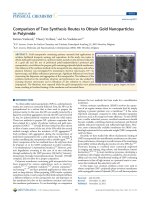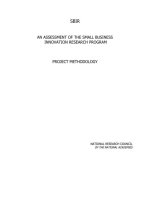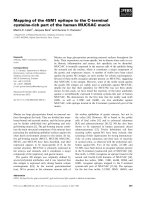Impacts of the safe routes to school program on walking and cycling
Bạn đang xem bản rút gọn của tài liệu. Xem và tải ngay bản đầy đủ của tài liệu tại đây (763.67 KB, 35 trang )
Impacts of the Safe Routes to School
Program on Walking and Bicycling
Noreen McDonald
University of North Carolina at Chapel Hill
1
Outline
• Children’s Travel
• Impacts of the Safe Routes to School Program
• Work @ ITS
2
Children’s Travel
3
25%
of the population
Source: American Factfinder
4
33%
of households
Source: American Factfinder
5
20%
of vehicle trips
Source: National Household Travel Survey
6
Why do we need to understand
children’s travel?
Predicting Adult
Travel
Infrastructure
Investments
Physical Activity
Opportunities
7
Safe Routes to School Program Impacts
8
Shift to Automobility
US Mode to School, 5-18 year olds
60
Auto
50
40
30
20
10
0
1965
1970
1975
1980
1985
1990
1995
2000
2005
School
Bus
Walk/
Bike
Transit
2010
9
Source: McDonald, et al. 2011. AJPM 41(2): 146-151.
SRTS Goals
• “enable and encourage children to walk and
bicycle to school”
• “make bicycling and walking to school a safer
and more appealing transportation
alternatives”
10
SRTS by the Numbers
$1.2
Billion
Funding
Source: McDonald, et al. 2013. AJPM 45(4): 401-406.
1 in 5
Schools
11
Research Question
• Do SRTS programs affect the proportion of
children walking and bicycling to school?
12
Research Design
Randomized
Controlled Trial
Quasiexperimental
• 4 states
• 801 schools
• 2007-2012
13
Approach
SRTS
Interventions
Neighborhood
Characteristics
yit f SRTSit , X it , Z i , Dt
Proportion Walking
and Bicycling to School
School
Characteristics
Time
Period
14
Data
Walking and
Biking to School
• Administrative
Data
• Student Report
• Parent Report
15
Source: National Center for Safe Routes to School
16
Data
Walking and
Biking to School
SRTS
Interventions
• 4Es
• Engineering
• Education,
Encouragement
• Enforcement
17
Data: Measuring SRTS
Step Function
%
Walk
Bike
Linear Function
%
Walk
Bike
SRTS
Time
Presence
(1/0)
Combined
%
Walk
Bike
SRTS
Time
Number of
Years
SRTS
Time
Presence
+
Number of
Years
18
Data
Walking and
Biking to School
SRTS
Interventions
School and
Neighborhood
• US Dept of Education
• Census
19
• WalkScore
Methods: Functional Form
Fractional Logit
exp( X )
Y
1 exp( X )
+
-
• Predictions inside (0,1)
• 0&1
• Marginal effects
• Unbalanced panel
Source: Papke and Wooldridge, 2008; Papke and Wooldridge, 1996
20
Results
21
Walking and Biking to School
30%
20%
10%
0%
Before
SRTS
Source: McDonald, et al. 2015. JAPA 80(2).
0.1-1.0
years
1.1-2.0
years
2.1-3.0
years
3.1-4.0
years
After SRTS
4.1-5.0
years
>5.0
years
22
Results: SRTS Program Impacts
Proportion Walk/Bike
-2
Education & Presence
Encouragement # of Years
Presence
Enforcement # of Years
Engineering
Presence
# of Years -1
Source: McDonald, et al. 2015. JAPA 80(2).
0
2
4
0.8
0.9
1.2
1.2
3.2
23
Results: SRTS Program Impacts
Proportion Walk/Bike
-2
Education & Presence
Encouragement # of Years
Presence
Enforcement # of Years
Engineering
Presence
# of Years -1
Source: McDonald, et al. 2015. JAPA 80(2).
0
2
4
Education and
Encouragement
0.8
0.9
1.2
1.2
3.2
• 0.9 point increase
per year
• Over 5 years, a
relative increase
of 25%
24
Results: SRTS Program Impacts
Proportion Walk/Bike
-2
Education & Presence
Encouragement # of Years
Presence
Enforcement # of Years
Engineering
Presence
# of Years -1
Source: McDonald, et al. 2015. JAPA 80(2).
0
2
4
0.8
0.9
1.2
1.2
3.2
25









